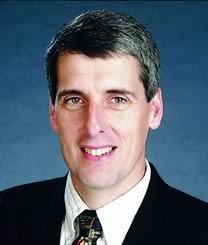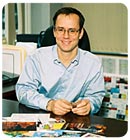Three companies spanning more than a century of printing services -
Edwards Brothers,
VistaPrint, and
Sandy Alexander - recently shared their green initiatives with
WhatTheyThink. Learning from the successes of others makes it possible for companies to move faster on the path of sustainability.
John Edwards, President/CEO of Edwards Brothers (founded 1893),
Robert Keane, President/CEO of VistaPrint (founded 1995), and
Mike Graff, President of Sandy Alexander (founded 1963) all have implemented a variety of green projects and processes. Here is what they had to say.
John Edwards, Edwards Brothers:
 Edwards Brothers has both FSC and SFI certifications and is in the process of securing SGP certification because we recognize the increasing pressures that our customers are feeling to be more environmentally sound. Our presses don’t care if the paper is recycled or not. Our only concern is will the paper go through the press without adding cost or producing higher waste. Our experience to date is that the papers work just fine. The biggest problem our customers have is that recycled sheets are more expensive. And that makes the economics more difficult to justify, although more and more people are using these stocks. Most of our sheets are SFI certified. The recycled and FSC materials are a smaller part of our list – around 10% -- because they are more expensive, less readily available, and usage is much lower.
The bottom line? Green can be green if you do it right. We’ve been doing it for 50 years because it makes financial sense. We’ve gotten better at tracking waste. We’ve enhanced our efforts significantly in the last five years and team members are on board and enthusiastically do what it takes to segment waste and recycle it properly because deeper segmentation of waste yields a higher return. Ultimately we’re still trying to reduce the amount of waste we generate. We recycle or use 97.5% of all raw materials entering the plant, shipping them out as finished products or as 27 different recyclable byproducts. Our goal is to boost that to 99% and we’re almost there. The fact that it pays and makes environmental sense is a win-win for us. I don’t know why any printer wouldn’t want to do it, but it is an investment – the scrap handling system equipment we installed cost $400,000 -- so you have to be smart about it.
Edwards Brothers has both FSC and SFI certifications and is in the process of securing SGP certification because we recognize the increasing pressures that our customers are feeling to be more environmentally sound. Our presses don’t care if the paper is recycled or not. Our only concern is will the paper go through the press without adding cost or producing higher waste. Our experience to date is that the papers work just fine. The biggest problem our customers have is that recycled sheets are more expensive. And that makes the economics more difficult to justify, although more and more people are using these stocks. Most of our sheets are SFI certified. The recycled and FSC materials are a smaller part of our list – around 10% -- because they are more expensive, less readily available, and usage is much lower.
The bottom line? Green can be green if you do it right. We’ve been doing it for 50 years because it makes financial sense. We’ve gotten better at tracking waste. We’ve enhanced our efforts significantly in the last five years and team members are on board and enthusiastically do what it takes to segment waste and recycle it properly because deeper segmentation of waste yields a higher return. Ultimately we’re still trying to reduce the amount of waste we generate. We recycle or use 97.5% of all raw materials entering the plant, shipping them out as finished products or as 27 different recyclable byproducts. Our goal is to boost that to 99% and we’re almost there. The fact that it pays and makes environmental sense is a win-win for us. I don’t know why any printer wouldn’t want to do it, but it is an investment – the scrap handling system equipment we installed cost $400,000 -- so you have to be smart about it.
Robert Keane, VistaPrint:
 I believe that the push for printers, and for all businesses, to become more environmentally friendly is not only the right thing to do - but that it is no longer a choice. So VistaPrint takes our environmental responsibilities seriously.
We have initiatives both big and small that will help reduce our environmental footprint. 18 months ago we were featured in CIO Magazine due to our deployment of more energy-efficient servers and virtualization technology in our primary data center, steps that have reduced energy usage by 75% and carbon dioxide emissions by several hundred tons per year from this initiative alone. We are testing customer acceptance of recycled paper, and we actively recycle scrap and other waste products in our facilities. We are designing all of our new facilities and our facility expansions to reduce emissions and water waste. And we are paying the full costs of employee-led initiatives such as office recycling, the elimination of disposable water bottles, and shuttle buses from our offices to public transportation hubs.
None of these initiatives is a cure-all, but in aggregate they really start to add up. You will see many more of them from VistaPrint in the future.
I believe that the push for printers, and for all businesses, to become more environmentally friendly is not only the right thing to do - but that it is no longer a choice. So VistaPrint takes our environmental responsibilities seriously.
We have initiatives both big and small that will help reduce our environmental footprint. 18 months ago we were featured in CIO Magazine due to our deployment of more energy-efficient servers and virtualization technology in our primary data center, steps that have reduced energy usage by 75% and carbon dioxide emissions by several hundred tons per year from this initiative alone. We are testing customer acceptance of recycled paper, and we actively recycle scrap and other waste products in our facilities. We are designing all of our new facilities and our facility expansions to reduce emissions and water waste. And we are paying the full costs of employee-led initiatives such as office recycling, the elimination of disposable water bottles, and shuttle buses from our offices to public transportation hubs.
None of these initiatives is a cure-all, but in aggregate they really start to add up. You will see many more of them from VistaPrint in the future.
Mike Graff, Sandy Alexander:
 In 2002, our Clifton, NJ, facility was first certified to the ISO 14001 environmental management standard. In 2006, our Florida facility was registered as well. In 2008, we added our Fairfield facility. ISO 14001 is still relatively rare among printers, since it requires a level of commitment as well as resources that most are probably unwilling or unable to devote. But it is an excellent framework for improving environmental performance.
We also have multi-site FSC, SFI and PERC chain of custody certifications. Chain of custody, as your readers certainly know, has become an absolute requirement in many sectors of our business.
The single most dramatic and impactful thing we did in the environmental arena was our conversion to 100% wind power. In 2005 we signed a 7-year commitment to buy renewable energy credits sufficient to cover all of our facilities. We can claim that the reduction in greenhouse gas emissions each year as a result of our use of wind power is equivalent to an automobile driving 25 million miles.
That purchase was part of a larger goal. We have pledged on the EPA Climate Leaders website to reduce our carbon footprint by 11% by 2012. In order to meet that goal, one of the things we had to do was identify significant energy-saving measures. Taken together, these measures have ROIs of over $1.5 million dollars over the next 3-5 years. This illustrates that being green is not just a moral imperative but is also a good business practice.
We are also working closely with the EPA’s Waste Wise program to implement effective waste-reduction strategies. We intend to turn solid-waste from a cost center to a revenue generator. Our stated target is “zero to landfill,” so to achieve this we have been focusing our efforts on recycling plastics, one of the few remaining categories of solid waste in our facilities that are not already being reused or recycled. We are currently experimenting with waste- to-energy solutions, plastic-derived fuel and a number of other recycling options.
In 2002, our Clifton, NJ, facility was first certified to the ISO 14001 environmental management standard. In 2006, our Florida facility was registered as well. In 2008, we added our Fairfield facility. ISO 14001 is still relatively rare among printers, since it requires a level of commitment as well as resources that most are probably unwilling or unable to devote. But it is an excellent framework for improving environmental performance.
We also have multi-site FSC, SFI and PERC chain of custody certifications. Chain of custody, as your readers certainly know, has become an absolute requirement in many sectors of our business.
The single most dramatic and impactful thing we did in the environmental arena was our conversion to 100% wind power. In 2005 we signed a 7-year commitment to buy renewable energy credits sufficient to cover all of our facilities. We can claim that the reduction in greenhouse gas emissions each year as a result of our use of wind power is equivalent to an automobile driving 25 million miles.
That purchase was part of a larger goal. We have pledged on the EPA Climate Leaders website to reduce our carbon footprint by 11% by 2012. In order to meet that goal, one of the things we had to do was identify significant energy-saving measures. Taken together, these measures have ROIs of over $1.5 million dollars over the next 3-5 years. This illustrates that being green is not just a moral imperative but is also a good business practice.
We are also working closely with the EPA’s Waste Wise program to implement effective waste-reduction strategies. We intend to turn solid-waste from a cost center to a revenue generator. Our stated target is “zero to landfill,” so to achieve this we have been focusing our efforts on recycling plastics, one of the few remaining categories of solid waste in our facilities that are not already being reused or recycled. We are currently experimenting with waste- to-energy solutions, plastic-derived fuel and a number of other recycling options.
What is your story? We'd love to share it. Please contact me using the "Send Gail an email" link under my picture.
Edwards Brothers has both FSC and SFI certifications and is in the process of securing SGP certification because we recognize the increasing pressures that our customers are feeling to be more environmentally sound. Our presses don’t care if the paper is recycled or not. Our only concern is will the paper go through the press without adding cost or producing higher waste. Our experience to date is that the papers work just fine. The biggest problem our customers have is that recycled sheets are more expensive. And that makes the economics more difficult to justify, although more and more people are using these stocks. Most of our sheets are SFI certified. The recycled and FSC materials are a smaller part of our list – around 10% -- because they are more expensive, less readily available, and usage is much lower. The bottom line? Green can be green if you do it right. We’ve been doing it for 50 years because it makes financial sense. We’ve gotten better at tracking waste. We’ve enhanced our efforts significantly in the last five years and team members are on board and enthusiastically do what it takes to segment waste and recycle it properly because deeper segmentation of waste yields a higher return. Ultimately we’re still trying to reduce the amount of waste we generate. We recycle or use 97.5% of all raw materials entering the plant, shipping them out as finished products or as 27 different recyclable byproducts. Our goal is to boost that to 99% and we’re almost there. The fact that it pays and makes environmental sense is a win-win for us. I don’t know why any printer wouldn’t want to do it, but it is an investment – the scrap handling system equipment we installed cost $400,000 -- so you have to be smart about it.
I believe that the push for printers, and for all businesses, to become more environmentally friendly is not only the right thing to do - but that it is no longer a choice. So VistaPrint takes our environmental responsibilities seriously. We have initiatives both big and small that will help reduce our environmental footprint. 18 months ago we were featured in CIO Magazine due to our deployment of more energy-efficient servers and virtualization technology in our primary data center, steps that have reduced energy usage by 75% and carbon dioxide emissions by several hundred tons per year from this initiative alone. We are testing customer acceptance of recycled paper, and we actively recycle scrap and other waste products in our facilities. We are designing all of our new facilities and our facility expansions to reduce emissions and water waste. And we are paying the full costs of employee-led initiatives such as office recycling, the elimination of disposable water bottles, and shuttle buses from our offices to public transportation hubs. None of these initiatives is a cure-all, but in aggregate they really start to add up. You will see many more of them from VistaPrint in the future.
In 2002, our Clifton, NJ, facility was first certified to the ISO 14001 environmental management standard. In 2006, our Florida facility was registered as well. In 2008, we added our Fairfield facility. ISO 14001 is still relatively rare among printers, since it requires a level of commitment as well as resources that most are probably unwilling or unable to devote. But it is an excellent framework for improving environmental performance. We also have multi-site FSC, SFI and PERC chain of custody certifications. Chain of custody, as your readers certainly know, has become an absolute requirement in many sectors of our business. The single most dramatic and impactful thing we did in the environmental arena was our conversion to 100% wind power. In 2005 we signed a 7-year commitment to buy renewable energy credits sufficient to cover all of our facilities. We can claim that the reduction in greenhouse gas emissions each year as a result of our use of wind power is equivalent to an automobile driving 25 million miles. That purchase was part of a larger goal. We have pledged on the EPA Climate Leaders website to reduce our carbon footprint by 11% by 2012. In order to meet that goal, one of the things we had to do was identify significant energy-saving measures. Taken together, these measures have ROIs of over $1.5 million dollars over the next 3-5 years. This illustrates that being green is not just a moral imperative but is also a good business practice. We are also working closely with the EPA’s Waste Wise program to implement effective waste-reduction strategies. We intend to turn solid-waste from a cost center to a revenue generator. Our stated target is “zero to landfill,” so to achieve this we have been focusing our efforts on recycling plastics, one of the few remaining categories of solid waste in our facilities that are not already being reused or recycled. We are currently experimenting with waste- to-energy solutions, plastic-derived fuel and a number of other recycling options.









